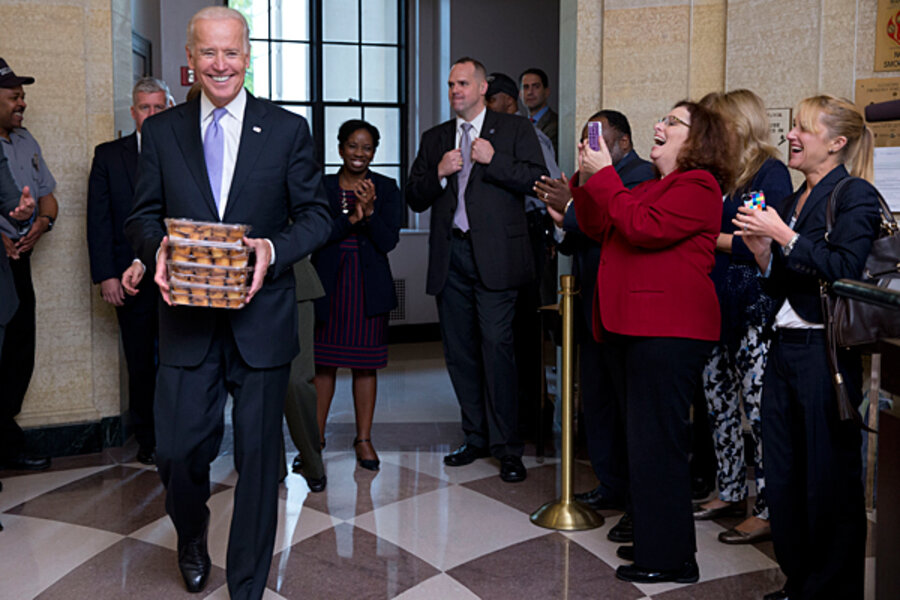Did shutdown really give Democrats a shot at retaking the House in 2014?
Loading...
| Washington
There is little doubt the Republican Party has suffered damage from the tea party-driven government shutdown that ended Thursday with barely any concessions from the Democrats.
In just a month, public favorability of the GOP dropped 10 points, to 28 percent, an all-time low for either party in the Gallup poll. Republican strategists are worried the shutdown will harm their party’s fundraising and help the Democrats raise money and recruit candidates.
But is the damage really enough to put Republican control of the House in jeopardy in the November 2014 midterms?
After all, a swing of only 17 seats in the 435-seat lower chamber would do the trick. And an analysis by the nonpartisan Cook Political Report now, for the first time in the 2014 House election cycle, puts more Republican seats “in play” than the 17-seat pickup Democrats would need to win control. Of the 15 seats that Cook Political re-categorized, all but one are now considered less safe for Republicans.
Many factors nevertheless mitigate against a Democratic takeover.
No. 1 is time. The election takes place in more than a year, and as the cliché goes, that is many political lifetimes away. Remember how Syria was going to sink President Obama’s second term?
The math for Democrats also remains extremely difficult. Ten Democratic-held seats are toss-ups, and so realistically, Democrats would probably need to win between 20 and 25 Republican-held seats to take over the House, says David Wasserman, Cook Political’s House watcher. And some of those takeovers would have to take place in districts with a decided Republican tilt.
Gerrymandering has made a lot of seats safe for both parties, but more-so for Republicans. That also weighs against a Democratic takeover, as does relatively low turnout in midterms. Minority and young voters, both key to the Democratic base, are prone to low turnout in non-presidential years – especially without Mr. Obama on the ballot. Historically, a president’s party almost always loses seats in his second midterm election.
“We have always maintained that House Republicans would need to engage in some spectacularly self-destructive behavior in order for Democrats to have any shot at netting 17 seats and a majority next November,” writes Mr. Wasserman. “Over the 16-day course of the government shutdown, House Republicans flirted with just that.”
Hard-line conservatives drove House Speaker John Boehner (R) of Ohio to seek to defund Obamacare as a condition for funding the federal government and lifting the debt ceiling. When Obama refused to negotiate, the government shut down. But Republicans had no Plan B, and ultimately relented with nothing to show for it. Obamacare wound up gaining in popularity.
The deal struck this week funded the government through Jan. 15, as bipartisan budget conferees work on a long-term budget plan that addresses entitlements, taxes, and the automatic spending cuts known as sequestration.
As long as conservatives don’t force another government shutdown in January, Republican analysts predict the party won’t pay too heavy a price in the 2014 midterms.
“But if we do have another shutdown, we will be stealing defeat from jaws of victory,” says Ford O’Connell, head of the conservative Civic Forum PAC.
Of the seats considered vulnerable few are held by members planning to retire, and incumbents hold a natural advantage in fundraising and voter identification. But in the Republican column, one California seat – held by Rep. Gary Miller – is now rated by Cook as leaning Democratic, owing to that state’s new “jungle primary” system in which the top two finishers in the primary compete in the general, even if they’re from the same party. As of now, it’s possible the race could wind up between two Democrats, freezing out Congressman Miller.
Another possible pickup for Democrats is in Florida, where veteran Rep. Bill Young (R) is retiring. It’s a tossup district, based on presidential voting patterns, and with no incumbent on the ballot, a strong Democratic nominee could win.
The irony for Republicans is that many of those holding seats considered “in play” are not hard-liners, and had nothing to do with fomenting the shutdown. Tea partyers tend to come from safe districts.
But Democrats have plenty of seats of their own to defend. On Cook Political’s list, 10 seats as tossups, and 14 only “lean Democratic.”
Going forward, says Mr. O’Connell, the best thing Republicans can do is let the difficult rollout of the Affordable Care Act – the computer glitches, the higher insurance rates some consumers are seeing, the unpopular individual mandate to buy insurance – dominate the news without the distraction of a shutdown.
“What they really need to be doing” he says, “is let the stories of Obamacare’s failure write themselves.”








